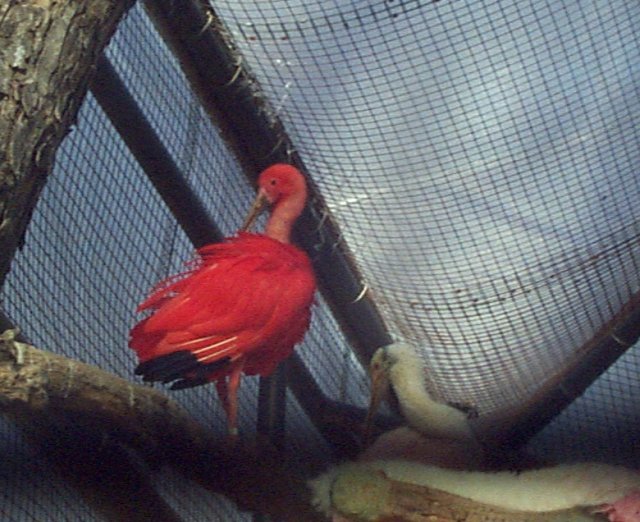 |
 |
| Name: Scarlet Ibis |
| Scientific name: Eudocimus ruber |
| Range: Central America and Northern South America |
| Habitat: Tropical regions and rainforests |
| Status: Not threatened. |
| Diet in the wild: insects, fish, meat, seeds, and fruits |
| Diet in the zoo: crustaceans, fish, amphibians, reptiles, and some vegetable matter. |
| Location in the zoo: currently not on exhibit |
| Physical description: Body length 22 to 24 inches (56 to 61 centimeters) Color is bright red in both sexes, with a long neck, long curved probing bill, black tipped feathers, and perching feet that are only slightly webbed. . |
| General information: The Scarlet Ibis is one of the most striking sights in the world of birds, flying, feeding and nesting in large groups. Some birds, especially those in the tropics, stay in the same general area throughout life. The Scarlet Ibis is classified with other birds of tropical America who have few or no close relatives except in other tropical regions. |


| Special anatomical, physiological or behavioral adaptations: The uniformly bright-red plumage of the Scarlet Ibis intensifies as the bird grows older. As with flamingos, the brilliant red color of the bird comes from pigments in the bodies of crustaceans on which it feeds. The long curved beak is used to probe for food in mud and shallow water, guided mostly by touch. It flies strongly with its neck extended, almost as if it were gliding. Like other birds, Scarlet Ibis fights with their beak, legs, and wings against enemies in order to protect themselves and their offspring. |
| Other Facts about the Scarlet Ibis
|

| Personal Observations: The feet of the Scarlet Ibis are used to grip tree branches and help them stay balanced. They eat mollusks and crustaceans, two of the organisms we studied in lab. The shade of red that the Scarlet Ibis has is unique and beautiful. |
| Related Links:
Scarlet
Ibis at the Hogle Zoo
These links might be interesting if you would like to see different kinds of birds who are featured at these zoos. |
| Page author: Tonya Townson
t0123@hotmail.com |
WhoZoo Home Bird Gallery Bird Index Animal Index |
| Source list:
The World Book Encyclopedia vol.2 1994 Edition; Academic American Encyclopedia vol. 3 1993 Edition; A Guide to the Birds of South America by R.M. de Schauensee |